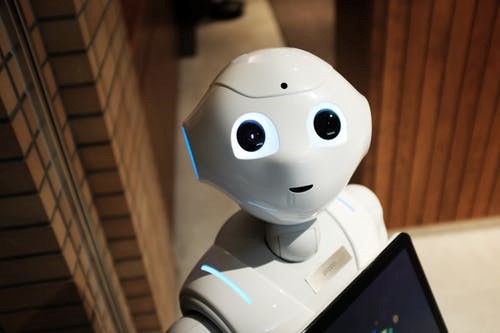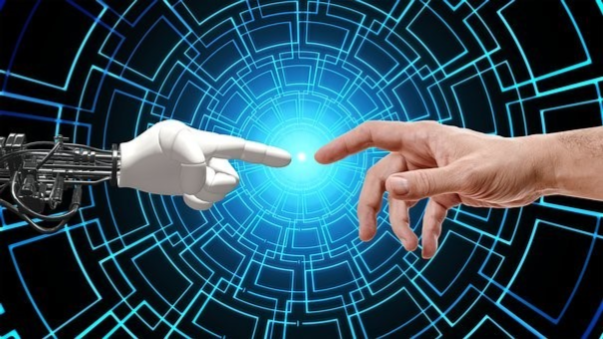How artificial intelligence and robotics is transforming business
How artificial intelligence and robotics is transforming business
Demystifying artificial intelligence and robotics
Artificial intelligence (AI) and robotics are no longer topics reserved for urban legends and sci-fi movies. In fact, artificial intelligence came into existence in 1956 but has taken many decades to become a reality. Many people fear being replaced by robots and generally don’t tend to consider the opportunities and possibilities of incorporating these technologies into their lives and business.
Artificial intelligence is around us in ways we may not realize, actively impacting our lives. Think about each time you open a Facebook newsfeed or do a Google search or purchase something online, AI is working in the background. AI and robotics are developing and improving daily, disrupting the traditional ways of working. Businesses can benefit massively from embracing them to increase efficiencies and productivity.
In defining AI, it is a label given to computing systems that exhibit some form of human intelligence, characterized by interacting in ways that seem ‘natural’ to humans, including learning, planning and solving problems. Even experts in the robotics industry struggle to define robotics in its entirety, other than to agree that robots are programmable machines that carry out tasks. AI-powered robots do not possess any natural general intelligence but are capable of problem solving and ‘thinking’ to some extent. You need not worry though, as robots are not able to perceive or feel things and will not overthrow the human-race any time soon.
Benefits of AI
Advancements in many disciplines such as computer science and engineering have improved on the traditional industrial robot to make them safer to work with and more efficient in a wider array of tasks. The incorporation of advanced sensors and connectivity have equipped robots with an element of agility, communication skills and the ability to learn. Through these mechanisms, AI is equipping robots with the skills required to perform more intellectually demanding tasks, rather than simply perform or replace manual labour. AI is driving productivity improvements, as these systems replace or augment humans and generate new business models. The functionality of AI extends beyond the factory and businesses (of any size) selling both products and services, and affects society as a whole.
The rise of AI is enabling smart machines to perform knowledge work previously reserved for skilled knowledge employees. Computers are now able to access, process and analyse relevant information to make judgements and solve unstructured problems creatively. Beyond the ability to ‘learn’, smart machines also have the capacity to communicate with knowledge workers and other smart machines. This allows for enhancement of employee skills to optimize business processes. Business opportunities arise from the automation of knowledge work by creating an avenue of real-time information access to unskilled workers and consumers, which could be used to improve on service and product offerings. Automation of knowledge work also holds the potential to fully automate certain tasks, thereby eliminating the need for certain knowledge employees. While this will certainly result in a degree of job cutting, the ultimate creation of value to the economy and society will compensate for this.
Some of the other benefits of AI include:
- Quicker times to bring products/services to market.
- Increased volumes of products and services.
- Improved skills set of workers.
- Reduction in production and operational costs.
- Improved and customized designs and products.
- More efficient supply chains.
- Little to no waste due to precision work and ability to perform 24/7, 7 days a week.
- Development of new industries, new jobs and alternative career choices for workers (social and economic growth).
- Reduced need to import skills and resources.
Artificial intelligence (AI) examples
Artificial intelligence has a wide range of uses in business, right down from the mundane tasks to ground breaking technologies giving businesses the competitive edge. Massive advancements have already and continue to take place in many sectors such as consumer goods, energy, financial services, healthcare, manufacturing, media, retail, social media and many more. One of the most common types of AI developing in business is machine learning, where algorithms (sets of instructions to perform a task) process large amounts of data rapidly. More data improves the modelling of the algorithms, identifying patterns and anomalies, faster than a human. Deep learning is critical in performing more advanced functions, analysing many factors at once making deep learning models more scalable.
There are many brilliant examples of how AI and AI-Robotics are shaking things up and transforming businesses. Let’s look at some of these examples in a little more detail:
1. Consumer Electronics – Many electronics are incorporating AI to do routine household tasks and improve peoples’ lifestyles. One such example is the mop and/or vacuum iRobot, which is a self-deployed mop and/or vacuum cleaner that uses AI to scan the room size, identify potential obstacles and remember the most efficient route to clean, without any human assistance. Another evolution in smart technology include virtual assistants such as Alexa (Amazon), Bixby (Samsung), Google Assistant (Google) and Siri (Apple) which mimic real conversations and are able to answer questions asked or respond to voice prompts thereby customizing one’s living experience e.g. automatically turn lights on/off or turn appliances on etc.
2. Healthcare – Enormous strides are taking place in this sector to save more lives and bring healthcare to the masses. AI powered prosthetics, also known as bionic limbs, have sensors to perform reactively and accurately, in some cases better than the original body part. Apps are being developed to help manage patient’s illnesses, medication and even determine gaps in healthcare treatments. Some apps provide concierge type services like online appointment booking, accessing medication prescriptions or even having access to a nurse/doctor 24/7 via video chat. Auxiliary robots help hospital staff with stocking, collecting items and cleaning. One of the oldest hospitals in the world, Massachusetts General Hospital has implemented AI-powered machines for disease detection, diagnosis and treatment with great success.
3. Financial Services – Most financial services companies are going to great lengths to secure the confidential and private transactional information of their clients. American Express is one such company that processes $1 trillion in transactions and relies heavily on data analytics and algorithms to curb fraud and save millions in losses. Another big trend in this sector is the robo-advisor which is basically an automated portfolio manager that uses AI and algorithms to scan large volumes of market data to predict best performing stocks, saving time and money.
4. Manufacturing – In the motor vehicle industry, AI is playing a key role in providing manufacturers with cutting edge technology such as data to assist with predicting when parts require replacing, when vehicle servicing is needed or monitoring vehicle performance to improve driver and passenger experience. Both Volvo, BMW and other luxury brands are taking engineering to another level by developing autonomous driving (driverless) vehicles and using additive manufacturing to produce parts. Additive manufacturing is a production technique on the rise using digital 3D design data to build up an object, layer by layer, using materials (metals, plastics and composite materials) in fine powder form. This way of manufacturing is also used by multinationals like Coca-Cola, Nokia and eBay to support individual needs and produce goods closer to the customer.
5. Retail – In addition to more convenient e-Commerce approaches in retail, many companies are nurturing deep and personal connections with their customers. They create AI to track consumer buying behaviour and create reward/loyalty programs to personalize each customers’ shopping experience, predicting and prompting sales. Amazon have just created their first ‘Amazon Go’ store using ‘just walk out’ technology (combining deep learning algorithms and sensors). The customer uses an app to enter the store, selects the products they want and leaves the store when done, with no queues and no pay points. The items taken are automatically added to their virtual card and deducted from the customers Amazon account.
What the future holds

There are many experts pioneering the future of AI and robotics and there is great controversy on the topic. The general consensus seems to be on the need for wisdom in planning ahead and the preparation required for safety engineering and risk management in the field, avoiding AI being programmed to do something devastating. Intelligence enables control and artificial superintelligence is the hypothetical AI where machines become self-aware and surpass the capacity of human intelligence. As long as the goals of humans and machines are aligned, there is no need for panic. In fact, a future of being empowered by technology could lead to a thriving life, potentially tipping the work/life balance, the current inequalities of power and wealth, as well as the sustainability and prosperity of the world as we know it, in everyone’s favour.
References
https://ehealthnews.co.za/artificial-intelligence-healthcare/
https://builtin.com/artificial-intelligence/examples-ai-in-industry
https://www.businessnewsdaily.com/9402-artificial-intelligence-business-trends.html
https://futureoflife.org/background/benefits-risks-of-artificial-intelligence/?cn-reloaded=1



